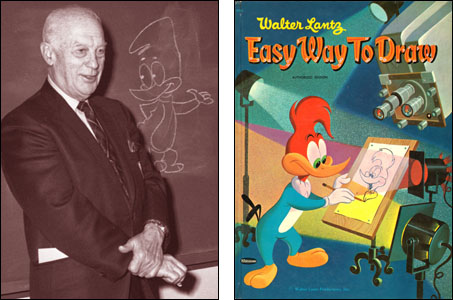On April 16 of 2007, I posted this here — a remembrance of a book that changed my life a little. I don't draw much anymore because, among other reasons, I got trapped in one of those vicious circles you hear so much about. The less I drew, the worse my drawing got…and the worse my drawing got, the less I drew. That I could/can draw at all has a lot to do with the lessons in this book published when I was six, and with cartooning lessons I got on my TV from Walter Lantz and a gent named Tom Hatten. Tom Hatten was the host of the Popeye cartoons on KTLA here in Los Angeles and he inspired a lot of kids — not just me — to want to learn how to do that. So did this book…
![]()
I mentioned recently here that my one-time love of Woody Woodpecker cartoons flowed from the drawing lessons that the character's "boss," Walter Lantz, used to give on his cartoon show. Let me expand on that and mention a book that I suspect figured big into the lives of many folks my age who got into animation or drawing. Around 1958 (though possibly before), the Whitman Publishing Company brought out Walter Lantz Easy Way to Draw, a "how to" cartooning book written clearly and properly for a young audience.
I doubt Mr. Lantz (seen below in the photo at left) had much to do with its contents. The book is credited to Frank McSavage and Norm McGary, two artists who worked a lot for Western Printing and Lithography, publishers of Whitman books and tons of coloring books, games and puzzle books featuring Woody and the rest of the Lantz menagerie. Western also created and printed the Lantz-licensed comic books published at the time by Dell…and this was such a lucrative relationship for Lantz that he seems to have surrendered a lot of control of his properties to Western. The designs of his characters were constantly changing on screen and when Western standardized them for their books and magazines, Lantz recognized that those artists (McSavage, especially) knew what they were doing and adjusted his films and the other merchandise to match. He also employed McSavage and McGary directly from time to time.

Easy Way to Draw is a great book and my copy, which I must have gotten soon after it came out, moved me to sit for hours and attempt to replicate the drawings it featured. There was a concise, understandable explanation of the principles of animation along with step-by-step diagrams on how to draw Woody and his pals. Lantz had all these characters like Homer Pigeon that I didn't really know that well…and as an avid reader of Walter Lantz comic books and watcher of Walter Lantz TV shows, if I didn't know them, no one did. But I learned to draw them about as well as a kid my age could have learned to draw them and I'm sure it made me like them more. One day in school — I don't remember exactly why — I did a big drawing of Homer Pigeon on the blackboard. All of the kids in class were impressed, even though none of them knew who it was, either. Alas, these skills had limited value. When I got a little older, I learned you couldn't attract girls by showing them how you could draw Wally Walrus.
I'd wager big that I'm not the only person in my age bracket who was encouraged in a career towards drawing and/or animation by this book. It appears to have been kept in print for some time even if that meant dropping chapters and slapping a more "modern" cover on it, which they did. Still, you don't see a lot of copies around because it encouraged its owners to draw right in the book or cut out certain pages. So either you loved the book enough to despoil your copy or you loved it enough to keep it in pristine condition and never want to part with it. I'm in the latter category. I wonder if anyone's done a "how to draw cartoons" DVD or computer program that is now having the same impact on the nine-year-old Future Cartoonists of America.